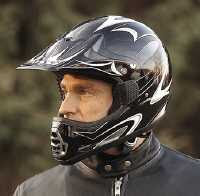A motorcycle is typically a two-wheeled vehicle run by a small, loud engine. These vehicles are basically motorized bicycles, but are structured with heavier, sturdier and more complex parts, implying that a motorcycle is more machine than bicycle.
Motorcycles have various uses, but the obvious primary use is to ride, to serve as a form quick transportation. Other uses: military and law enforcement, sports/racing, touring, and serving as a symbol of freedom, depending on who is riding it. Motorcycle conventions also allude to yet another purpose for the motorcycle: a show piece! Motorcycles, like automobiles, are also works of art for those who are mechanically inclined or like to showcase their unique and innovative machines (concept bikes).
Motorcycles: Types
Road Motorcycles: motorcycles built for riding on paved and public roads. These motorcycles have shallow treads and 125cc engines capable of reaching 100 mph (160km/h). Some can go over 125 mph (200 km/h). These aren’t designed for racing, but merely for public transportation. They have license plates, blinkers, and other accessories necessary for riding on public roads.
Cruiser—reminiscent of the style of American machines during the 1930s through the 1960s. These motorcycles are designed for long distance riding and provide some comfort. Harley Davidson, Excelsior, Henderson, and the Chopper are cruisers.
Sports bike—performance bikes that are usually lighter and smaller in structure than the cruiser. These motorcycles are racing bikes and have four-cylinder engines ranging 600cc to 750cc. “Super bikes” can also provide up to 1,000cc.
Touring bike—these motorcycles offer large displacement parts, to protect from inclement weather and heavy winds; high-torque engines; comfortable, upright seating positions; and large capacity fuel tanks for long-range mileage. Types of tour bikes include: Full-dress Tourers, Standard Tourers, Global On+off Road Tourers, and Sports Tourers.
Naked bike—reduced in parts to its essentials, this bike emphasized function, performance, and ergonomics over the appearance that is a preferred feature of the sports and tour bikes. These motorcycles are also referred to as “street” bikes. The Yamaha Seca II is a fine example.
Scooter—Motor Scooters are short-distance motorcycles with small wheels (357 mm or 14 in. in diameter) and engines in the swing arm. Typically, these run less than 125cc, but some larger scooters exceed 250cc. One popular scooter is the Honda Lead 80.
Moped—a bicycle/motorcycle hybrid with a two-stroke engine that goes up to 50cc. These have demanding licensing in some localities. Their popularity dropped in mid-1980s, but they are still used today.
Off-road bikes—these include dirt bikes and are built for rougher terrain. They have larger, deeper-treaded tires, small engine, long suspension travel and high ground clearance, and no street accessories. These motorcycles have engines that comprise two-strokes at a single cylinder or four-strokes at a single cylinder, and can go as low as 50cc or as high as 750cc, depending on age of the riders and the size and style of the engine. Trial bikes, which go no more than 250cc, are off-road motorcycles. These are used for Motocross and Enduros.
“Dual-Sport” and Adventure-Touring—these are “on-off road” bikes. They are similar as the “off-road” motorcycles, but they are equipped to ride on public roadways as well.
Farm bike—a variant of the trial bike, this motorcycle was used by dairy farmers in New Zealand during the early 1960s. These are low-pressure motorcycles used for easy transportation.
Derny bike—a specialized motorcycle used in track cycling for blocking air-resistance for racing bicycles.
Towing bike—designed by a Swedish company, this motorcycle has a high-torque engine and retractable trailer for towing cars and light trucks. The only one in existence is the Retriever, an altered form of the Honda GL 1800 old Wing.
Concept bike—these are prototypes created to measure the response to innovative designs, new and unique technologies, cost effectiveness, and other factors. Most are never realized, but a small few are released in compromised combination form, taking into consideration marketing realities, public reaction and preference, and manufacturing capabilities.
Motorcycles are the rage of the road—and off the road. These machines are as inspirational as they are dangerous, and they require as much respect as they do training and practice to operate. If treated well, motorcycles will treat riders well.
http://wordmagazine.co.uk/users/sandy6677
Subscribe to:
Post Comments (Atom)

No comments:
Post a Comment